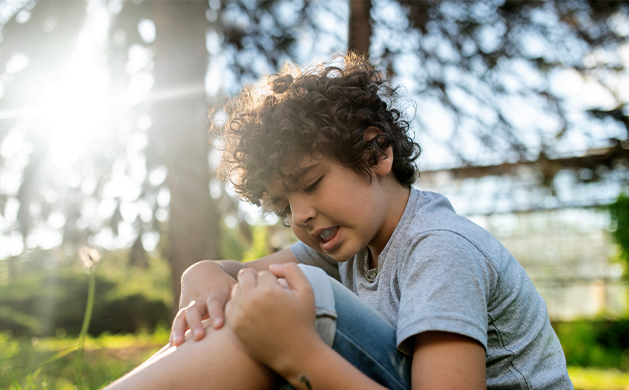Juvenile arthritis is one of the common chronic diseases of childhood. Joint pain is a common symptom. This article will give you a detailed view of the types, symptoms, diagnosis, and treatment options for Juvenile arthritis.
Juvenile idiopathic arthritis, or JIA, is the most common type of arthritis in children under 16. It can cause persistent swelling, joint pain, and stiffness. Some children may develop symptoms for only a few months, while others experience them for many years. Some types of juvenile idiopathy can contribute to serious complications, such as growth problems, eye inflammation, and joint damage. Childhood arthritis can result in permanent physical damage to joints. Knee arthritis can make it hard for the child to walk, and arthritis in hands and fingers causes deformity resulting in total disability in managing everyday tasks. The treatment aims to control inflammation and pain, improve function, and prevent damage.
JIA is a diagnosis that applies to all forms of arthritis of unknown causes; they all have in common a chronic inflammatory process targeting the membranes of the joints. It is still not understood what causes juvenile arthritis. However, juvenile arthritis is an autoimmune condition. Your immune system is your body’s way of defending itself against illness, bacteria, and injury. Your body can defend itself by causing swelling or inflammation. But when dealing with this type of arthritis, your body creates inflammation in joint/joints when it doesn’t need to. This inflammation then contributes to pain and stiffness.
Is juvenile arthritis genetic?
Rarely, two people in the same family have juvenile idiopathic arthritis, but it is very well-known that genetic factors are included. This is associated with the genes that are passed down from your parents. JIA is thought to be caused by a combination of genetic and environmental triggering factors. No evidence suggests that a specific infection gives rise to JIA, but an infection may trigger your immune system’s response and affects your joints.
What are the common symptoms?
The common signs and symptoms of JIA are:
-
- Stiffness – You might notice your child becoming clumsier than usual, especially in the morning or after naps.
- Pain – While your child might not complain of joint pain, you may notice that they limp, especially after waking up or after a nap.
- Swelling – Swelling in the joints is common but is often first observed in larger joints such as the knee.
- Rash, fever, and swollen lymph nodes – In some children, swollen lymph nodes, high fever, or a rash on the trunk may appear, usually worse in the evenings.
What are the types of Juvenile arthritis?
Juvenile idiopathic arthritis can affect a single joint or many. There are several subtypes of juvenile arthritis, but the main ones include systemic, oligoarticular, and polyarticular. Which type your child has usually depended on the signs, the number of joints affected, and if fever and rashes are prominent features.
Like any other form of arthritis, JIA is characterized by times when symptoms flare up, and symptoms may be minimal. These arthritis types are as follows:
-
- Systemic-onset – This type of juvenile arthritis is rare. It can contribute to joint pain, swelling, and inflammation all over the body. Symptoms are enlarged glands in your neck, under your arms, and around your groin. Your doctor may also find an enlargement of your liver, and occasionally, the covering of your heart is inflamed.
- Oligoarthritis – This JIA affects fewer than five joints, most often in the elbow, knee, and ankle. It can cause inflammation of the middle layer of the eye. About half of all children with JIA have oligoarthritis. The type of JIA is more common in girls than in boys. In some patients, it may spread to involve more joints eventually.
- Psoriatic arthritis – This affects children dealing with arthritis and psoriasis (a rash that progresses to a red patch or skin lesion covered with a silvery-white buildup of dead skin cells.
- Polyarthritis – This type of rheumatoid arthritis affects five or more joints, most probably the same joints on each side of the body. In this condition, joints in the jaw, neck, hands and feet are majorly affected.
- Enthesitis-related arthritis – This JIA type often affects the eyes, spine, hips, and entheses (where tendons adhere to bones). This is usually developed in boys older than eight years of age.
Moreover, children with a history of preceding gastrointestinal or urinary tract infections are more likely to get reactive arthritis. Initially, children may have symptoms including diarrhoea, vomiting, fever, abdominal pain, or pain with urination.
Diagnosis of Juvenile arthritis
Diagnosis of Juvenile arthritis may be difficult because a child may have no symptoms, and some of the symptoms can be associated with other conditions. Also, there is no test for JIA; the diagnosis excludes other diseases that may cause similar symptoms, such as infection, fibromyalgia, lupus, Lyme disease, bone disorders or break, or cancer. A doctor will begin the diagnosis by collecting the complete medical history and conducting a physical exam. Additional tests might be performed to determine the type of arthritis the child has.
Treatment for JIA
Treatment for JIA includes both exercises and medications. The treatment is also based on the type of arthritis the child has. For example, those with polyarticular juvenile arthritis (that affects more joints) and who show positive results on the rheumatoid factor test cause more joint damage and may require more aggressive treatment. The goal of the treatment is:
-
- To provide joint pain relief
- To reduce swelling
- To enhance joint mobility and strength
- To prevent joint damage and associated complications
Medicines used for the treatment of JIA:
-
- Nonsteroidal anti-inflammatory drugs, also known as NSAIDs, treat pain and swelling. These include naproxen and ibuprofen.
- Slow-acting rheumatic drugs are also helpful in treating pain and swelling over time. These are also known as disease-modifying anti-rheumatic drugs (DMARDs).
- Corticosteroids are also effective at treating pain and swelling. Steroid injections are given into the affected joints.
- Antimetabolites are aimed to help reduce further joint damage and restore joint function.
Treatment focuses on preserving a child’s quality of life by enabling them to be involved in regular activities, play, sports, and social activities.




